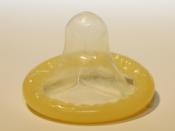CONTRACEPTION
Almost 3,500 years ago, men in Egypt wore condom-like sheaths as attractive and
eye-catching penis covers. By the 18th century, condoms were being made from sheep
intestines. In Victorian England, sexual stimulation was believed to shorten one's life, so
sex once a month was considered more than enough. In the ancient Middle East, Arabs
placed pebbles in the uteruses of female camels when they set off on long journeys. They
thought that a foreign object in the uterus prevented pregnancy. In today's society, there
are many types of contraceptives designed to fit our changing lifestyles. Eighty-five
percent of women who don't use contraceptives during vaginal intercourse become
pregnant each year. The only guarantee against pregnancy is not having intercourse, but if
used correctly the modern methods of contraception can reduce the risk of pregnancy.
Except for abstinence, the male condom, which is made of a tight material that
covers the entire penis, is the safest way to prevent AIDS and STDs. They are also nearly
one-hundred percent effective in preventing pregnancy when used properly and with
spermicide. The failure rate of a condom, when used correctly and by itself, is about two
percent. More often they fail around twelve percent of the time. There are a few different
types of materials that condoms are made of . The most popular are made of latex.
Polyurethane or animal skin are also used. The latex condom is the strongest of the three.
The many kinds of condoms on the market are lubricated, non-lubricated, ribbed, and
lubricated with spermicide. They also come in a wide variety of sizes. All of these can be
purchased at local drug stores, gas stations, grocery stores, health clinics, and many
doctors' offices.
A more recent type of birth control is the female condom, which is...



Comment
Very informative and well-organized, although there are some lapses in spelling and grammar.
3 out of 3 people found this comment useful.